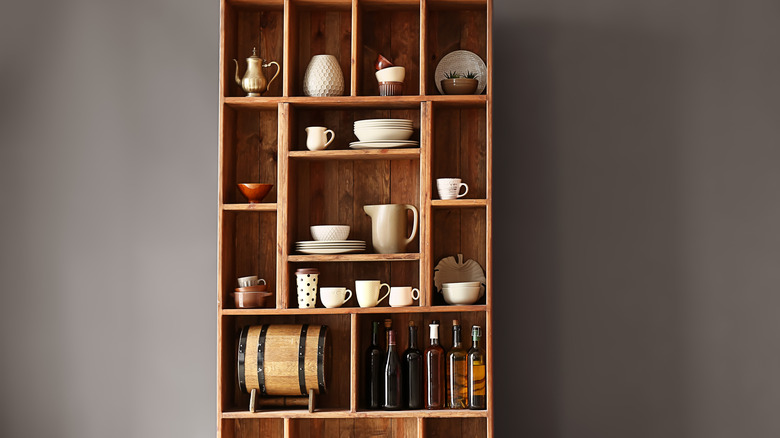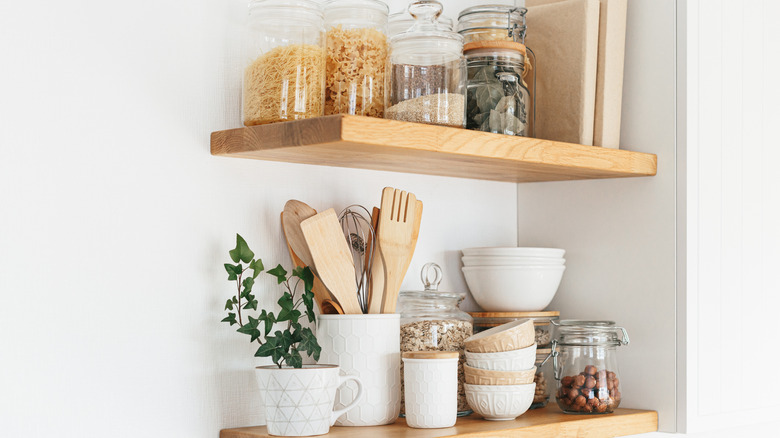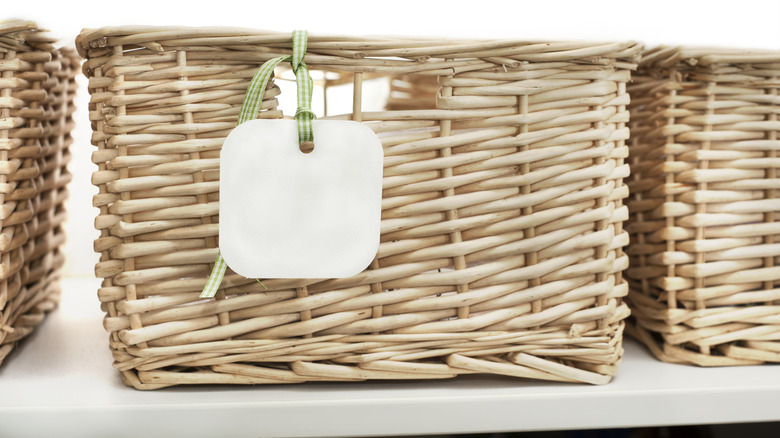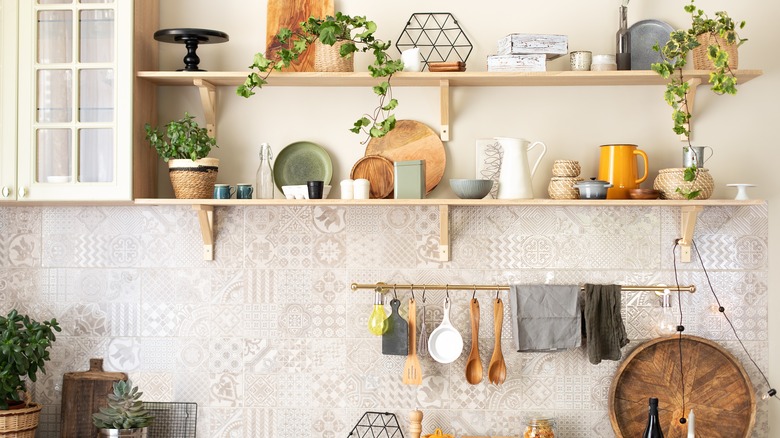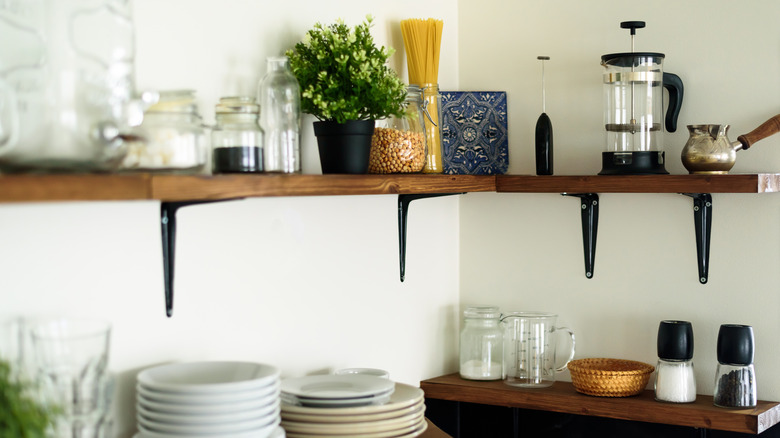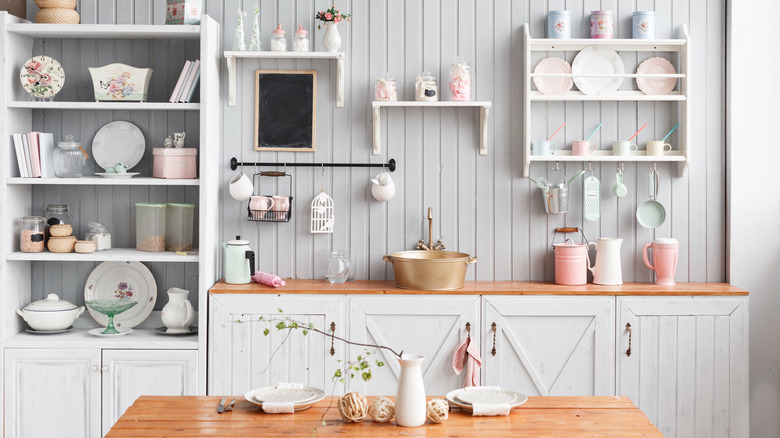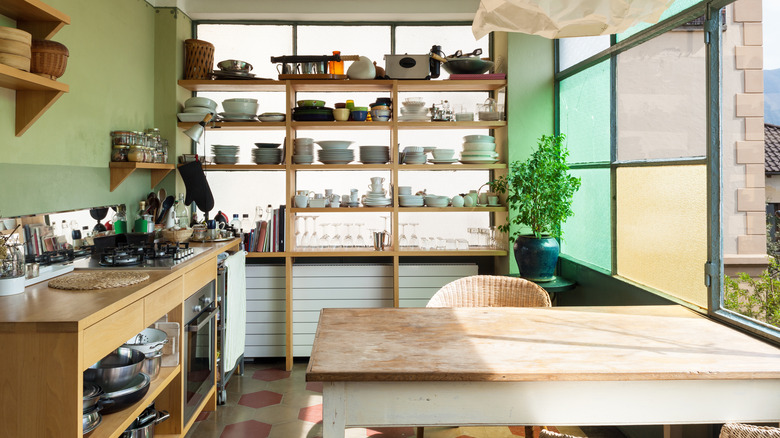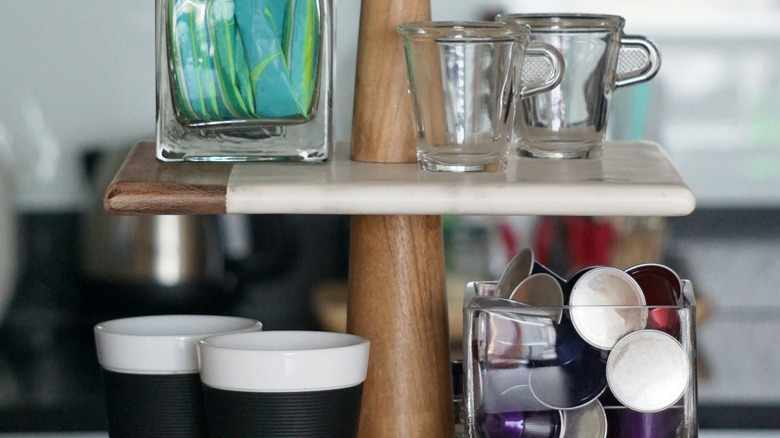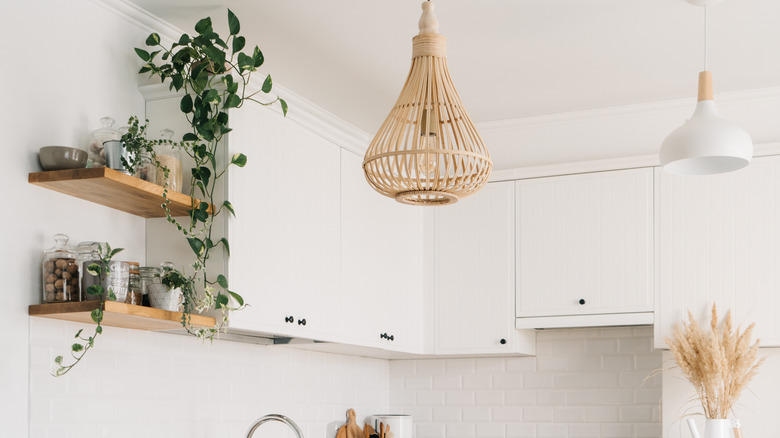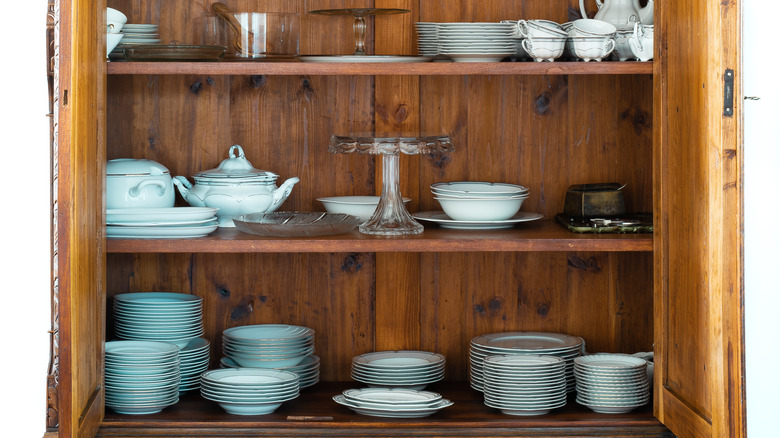How To Maximize Space On Open Shelving
One of the most controversial things about having open shelving in kitchens is that you can't maximize the space there or else it'll look cluttered. But designers know how to pack them stylistically. House Digest exclusively interviewed six home design experts to glean their suggestions for maximizing the space in open shelving.
The designers recommend a variety of strategies for solving the space-versus-style dilemma on open shelving. They provide tips for grouping, stacking, spacing, and hiding the objects that you want to store or display on your shelves. To achieve maximum design impact from the available space, the experts consider the color, texture, shape, and size of objects placed on the shelves. After all, open shelving puts your possessions in full view of anyone who enters your home. The overall effect can be either well-designed and attractive, or it can be chaotic. With a little ingenuity and advice from the experts, you'll be surprised at how stylish the open shelving in your home can be.
Group items by color and shape
Let's face it. You have limited shelf space and a large number of objects that need to be stored there. Consequently, you find yourself packing the items in as closely as possible. You can get away with packing more on the shelf if the items look attractive packed by color or shape.
"My suggestion is to group items together by color and shape. This will create a more cohesive and organized look," says interior designer Robert Moors. "For example, you can group your white dishes together on one shelf and your colorful plates on another. You can also group your glassware by shape and size. This will make it easier to find what you need and will create a more aesthetically pleasing display." Taking Moors' suggestion, you can maximize the shelving space while simultaneously creating a harmonious and well-organized workspace in your kitchen. When kitchen items are grouped thoughtfully on shelves, you'll always be able to reach for the just-right dish, cup, or utensil while you're busy with food prep or cleanup.
Use baskets and bins to hide the clutter
Not every object that you store on your open shelves is a work of art. In fact, many small, utilitarian items need a place to live on your shelves without being on display. Fortunately, there are tons of attractive bins and baskets available in stores, online, and in thrift shops. Pick up a few that complement your decor, and you'll be able to hide the little things that clutter your shelves and detract from a stylish presentation.
Using bins and baskets will help you pack in more items without overwhelming the eye. "Another idea that I like the most is to use baskets or bins to store smaller items. This will not only make the shelves look neater, but it will also help you maximize space," says Moors. "You can use baskets to store things like utensils, spices, or even snacks. Labeling the baskets will make it easier to find what you need and will add a personal touch to your kitchen." You can use this strategy to get organized while you tidy up your shelves. With items grouped logically and labels attached to your baskets, you'll be able to quickly locate the necessary tools and ingredients while you're cooking.
Leave some empty space
"Don't feel the need to fill every inch of your open shelves. Leaving some empty space will make the shelves look less cluttered and give your eye a place to rest," says Adam Moore of Paradise Home Cleaning. That way you can pack more on different shelves without making the space feel overwhelming. If the eye perceives a few empty spaces, the brain makes more sense of the stacks of items stored on the shelves. Therefore, it's helpful to edit the objects on each shelf to make room for negative space.
When you consciously incorporate negative space into the visual presentation of the items on your shelves, you elevate the look to a more orderly and refined aesthetic. The empty space between objects allows the overall design to breathe. Additionally, you can use negative space to showcase objects that have special meaning or visual interest. When these pieces are set apart from the other items on the shelf, they stand out to the viewer.
Add different materials and textures
Open shelving can look cluttered if it's one-dimensional. But it can feel cohesive — even when packed — if you have a range of carefully curated textures. "Consider incorporating different materials and textures to add visual interest to your shelves," shares Jonathan Faccone, a real estate investor and developer. "Instead of sticking to just one type of material or finish, mix and match different textures and finishes, such as wood, metal, or glass. This can create a dynamic and eclectic look that is sure to impress." Do this and you can probably add more to your shelves — it'll look like a style choice rather than a storage problem.
For example, you can curate a kitchen shelf to display ironstone dinnerware, glassware, and metal utensils all in one well-organized design. Add a green houseplant (living or faux) to the shelf, and you've created a visually pleasing vignette. Suddenly, your open shelf is not merely a utilitarian place for storing your kitchen stuff. Instead, it becomes an integral part of your room's inviting decor.
Limit your color scheme
Your shelves can look cluttered if you have too many colors. "To prevent your open shelves from looking too cluttered, choose a limited color palette for the items you place on them," recommends Patrick Grayson, the founder & CEO of Paramount Property Buyers. "For example, you could focus on whites and grays or warm tones like beige and brown." Bring out all of the items in that color tone and pack them onto the shelves, but leave everything outside of that color scheme out.
To do this, you'll need to make decisions about which items live on your open shelves and which ones get stashed away behind cabinet doors. Additionally, you might keep a color scheme in mind when you're shopping for new houseware items. Keep in mind that the overall visual impression of your open shelving is an important part of your decor scheme. You can make it harmonious with your room's design by choosing objects in complementary colors to store and display out in the open. The coordinated use of color allows you to fill your shelves more densely while maintaining a cohesive look.
Group like-items together
If your shelves feel chaotic, it might be because you're not grouping like items together. "Instead of placing individual items randomly on the shelves, group similar items together. For example, group all your dishes together on one shelf, and stack them in an aesthetically pleasing way," says Grayson. This will make your shelves appear less messy and allow you to add more.
Decorators and home organizers use the strategy of grouping similar objects together for both aesthetic and utilitarian purposes. When you're decorating open shelves, it's a practical strategy for maximizing the space. Think of what would happen if you add two more plates to a stack of six plates. It doesn't make the shelf look messy, right? However, if you stash those two plates on a shelf next to a coffee mug, the blender, a stack of saucers, and a spatula, the unrelated objects form a jumble that prevents you from adding more to that shelf. It's not merely a design mistake but also a practical obstacle to maximizing your storage space.
Add risers
Add visual interest (and double your storage!) by adding risers to some of the shelves. "Risers or tiered trays are great for organizing items on the shelves and creating space between them. This will ensure that everything has its own place and looks neater," says Grayson. For example, the wood shelf risers from Food 52 add style and practical storage space to your open shelves.
Position a few shelf risers on some but not all of your open shelves. You'll not only maximize the storage by adding more horizontal surfaces, but you'll introduce new possibilities for creating visual interest. You can showcase special objects by placing them on higher levels than utilitarian items. Additionally, you can separate groups of objects to create a more orderly appearance. For example, you might corral a group of small objects between the two vertical supports of a shelf riser and display the more decorative items on the horizontal surface above.
Hide the less appealing elements
If your shelves are deep enough, you can hide the more practical objects, like crockpots or your least favorite coffee mugs. "You can hide less appealing objects by placing them closer to the wall or even behind some decor pieces or, let's say, pretty plates," says Mariya Snisar, the Head of Interior Design at Renowell.
Wouldn't it be nice if every small appliance, dish, and utensil in your kitchen was a work of art? But in the real world, that's not the case. However, you can maximize the available shelf space by bringing the more aesthetically pleasing items to the forefront. In addition to storing your kitchen stuff on the shelves, think of adding a few decor pieces to serve as camouflage for the boring-but-necessary things. Using a piece of decor such as an urn, a vase, a houseplant, or a framed picture on a stand, you can dress up the open shelves and hide the utilitarian objects in the background.
Change the way you stack
Okay — you've grouped like-objects and stacked your dishes, but the open shelving still looks messy. It might look messy because you're stacking too high. "It's important to choose your dinnerware strategically if you want to display them on open shelves," says Kelin Zhao of Hydrangea Treehouse. "Opt for clean, aesthetically-pleasing plates and bowls, and consider stacking 4-8 of the same items in 1-2 piles. This way, you can store plenty without cluttering up the space and keeping it stylish."
Stacks of dishes and other objects that completely fill the vertical space contribute to an overwhelming visual impression. When you shop for dinnerware, keep in mind the look that you want to achieve on your open shelving. Overly thick and bulky dishes may not be the best choice because they do not stack neatly. Kitchen items with sleek and slim lines might be the preferable choice to pack your open shelves without creating an untidy mess.
